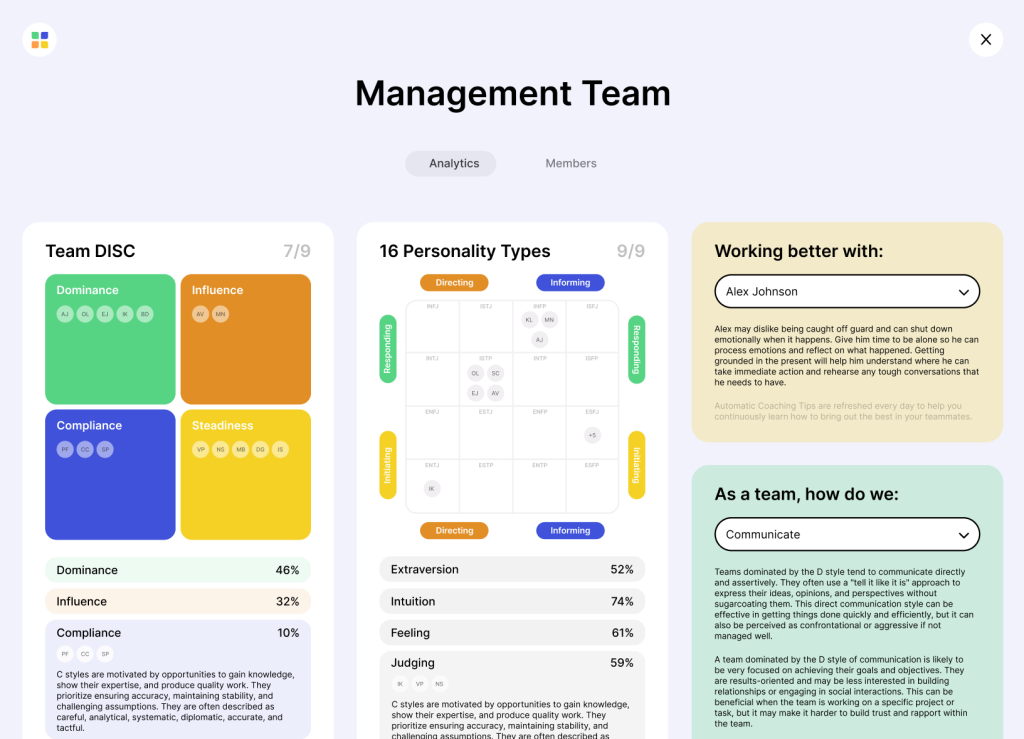Each of the nine Enneagram types has distinctive characteristics, motivations, and worldviews. We all have one of the nine Enneagram types that best describe our personality and have the most significant influence on us.
Knowing the underlying motives of each Enneagram type might assist you in connecting and empathizing with others. We all have our inner fears and aspirations.
We may not have the same appearance on the outside, but we all desire the same things deep within us. We crave friendship, acceptance, love, and respect.
This article will cover the basics of how the Enneagram works and introduce each of the nine Enneagram types to you.
You will also learn about Enneagram wings and the different levels of enneagram type development. This article will be handy for beginners who want to understand the different Enneagram types.

What is the Enneagram in Psychology?
The Enneagram personality test is a personality framework that categorizes individuals into nine types. Each personality type has its motives, desires, and behavioral tendencies.
How each of the nine Enneagram types views, the world is determined by their core belief. This core belief fuels your innermost desires and fears.
It essentially determines your outlook on the world and the people around you. However, your core beliefs are not always correct. They may become a blind spot that prevents you from seeing the bigger picture. Thus, it is essential to understand your Enneagram type and how it may influence your worldview.
Knowing this will allow you to widen your perspective on the world and be more proactive in facing different circumstances. Some Enneagram types have strong emotions, while others wish to hide their feelings in some way.
Each personality type has a set of beliefs that inspire and steer them to perform certain behaviors and make specific decisions.
You may find an explanation of the behaviors that puzzled you once you understand your Enneagram type. Your Enneagram type also assists you in understanding how you may respond to stress.
The Enneagram describes how each personality type responds to stressful and supportive situations. It offers you opportunities for continuous self-improvement and a way to understand others better. The following section will give you a brief overview of the nine Enneagram types.
The 9 Enneagram Personality Types Explained
Enneagram Type 1 – The Perfectionist
Personal integrity and discipline are fundamental to individuals with Enneagram type one. They focused on fixing what they perceived as wrong and always doing the right thing. They are well-known for their honesty, trustworthiness, and level-headedness.
Ones are incredibly responsible, to the point that they may dislike those who avoid taking responsibility for their life. They have high expectations and view the world in black and white. They are prone to being judgmental, both to themselves and others.
They strive to be correct and accurate every time. Ones are idealistic and will go to tremendous lengths to make the world a better place. Acknowledging their shortcomings and embracing other people’s viewpoints are critical components for their personal development.
Read more: Enneagram 1: The Perfectionist
Enneagram Type 2 – The Helper
Relationships are essential to Enneagram type two. They thrive in making connections with other people and their wants and feelings. They are naturally talented at empowering others and supporting them to realize their full potential.
However, they find it challenging to direct their attention inward and discover their inner desires. They desire to be acknowledged and loved by others.
And they will do anything within their capability to attain the acknowledgment and love they wish, even if it means changing themselves.

Twos need to be cautious about what they internalize from the opinions and information around them.
They find it difficult to get upset and set personal boundaries. However, they may occasionally experience emotional breakdowns when placed under extreme stress.
Twos must recognize that while winning the acceptance of others has its benefits, it shouldn’t be done at the expense of self-love.
Enneagram Type 3 – The Achiever
Threes are “achievers” who devote their time and energy to achieving their goals. They play an active role and work relentlessly to achieve their ambitions and aspirations. They are very adaptable and enjoy the feeling of exceeding others’ expectations.
They prefer to be busy and are constantly on the move. Their need for constant action makes them difficult to stop or slow down. Their obsession with maintaining their image and accomplishing goals might compromise their health and well-being.
Focusing on recognition or monetary rewards while losing touch with their inner-self is a concern for Threes. It is hard for them to move away from their achiever role to get in touch with their feelings and determine what is best for them.
Enneagram Type 4 – The Individualist
Fours are “Individualists” who are sensitive, reflective, and expressive. For them, something is always missing within themselves or in their lives. This tends to lead to fulfillment through romantic idealism, unconventional lifestyle, and creative works.
Fours are envious of others when they compare themselves to them. They crave purpose and meaning in practically every aspect of their lives. Many Fours are accomplished artists who excel in presenting their feelings through art, music, and poetry.
They are passionate about what they do to the extent that they may sometimes be seen as overly emotional.
While they constantly strive to display a positive image to others, it is more critical to show their genuine self. Their awareness may shift back and forth between empathizing with others to their inner world.
Most of the time, they prefer spending time alone and keeping their distance from others. For Fours, the answer to personal growth is to balance melancholy with the ability to be happy.
Read more: Enneagram Type 4 Personality
Enneagram Type 5 – The Investigator
Fives are known as “Investigators.” They are intellects who enjoy pursuing knowledge to make sense of the world around them. They are insightful, observant, and curious.
Fives place great importance on individual privacy and independence. Personal independence may allow Fives to disconnect from others and emotional burdens.

But it may also result in them feeling lonely. For some Fives, developing connections or building relationships with others is a huge issue.
While others may value friends and family, they still require time to be alone to pursue their hobbies or personal projects.
Fives must overcome their inclination to retreat or hide from others by proactively reaching out to others. They can take the first step to start a conversation and express their feelings or thoughts to others.
Enneagram Type 6 – The Loyalist
Sixes are “Loyalists” who utilize their sense and knowledge to analyze the surroundings and determine if others are friendly or dangerous. With their preference for security and belongingness, they are always putting the safety of themselves and others first.
Sixes excels at foreseeing issues and finding solutions to handle the problems. They need to understand the rules and regulations and establish agreements before starting something. When placed in an uncertain situation,
Sixes may question others’ trust and commitment or doubt their capability. Some Sixes are indecisive, worry constantly, and procrastinate.
Other Sixes may jump into action without any hesitancy. It’s an attempt to prepare themselves physically or mentally to overcome their fear.
Other Sixes may jump into action without any hesitancy. It’s an attempt to prepare themselves physically or mentally to overcome their fear. Sixes needs to start trusting others and themselves to have the strength to act in the face of doubt or challenge.

Enneagram Type 7 – The Enthusiast
Sevens are free-spirited, enthusiastic, and spontaneous. Enthusiasts spend most of their time pursuing pleasure and living their life to the fullest. They bring a cheerful and open-minded attitude to everything they do. They dislike being restricted to doing one thing at a time.
Instead, they prefer to keep their options open. Sevens can be outstanding conversationalists yet are less preoccupied with their image or gaining others’ approval. They seek enjoyment and fun from going on adventures, exploring the world, or intellectual pursuits.
Sevens are avid consumers of innovative thinking, cutting-edge technology, and joyful experiences. But too much fun and pleasure might not be a good thing for them.
As their interest in something can change quickly, it can be difficult for them to get into details and stay on track in their professional and social life.
Enneagram Type 8 – The Challenger
Eights are known as “Challengers.” They are assertive and have a high level of energy. Eights are capable of leading others and taking charge of circumstances. They are active and strong but may come across as aggressive and scary to others at times.
Eights prefer doing things their way and dislike being bound and dissatisfied with rules and regulations. They give their utmost to protect themselves and others by establishing control over their surroundings. Fairness and equality are the top priorities of Challengers. They are prepared to put up a fight if they feel that they have been mistreated.
They believe that displaying vulnerabilities and weaknesses will allow others to attack them. Eights find it challenging to balance their need for control with interdependence and collaboration. They also need to learn how to manage their frequent obsession with power.

Enneagram Type 9 – The Peacekeeper
Nines are “Peacekeepers” devoted to keeping peace and harmony for themselves and others. They are gentle, kind, and easy-going. Nines are adept at approaching things from several perspectives. It could become a challenge for them to make individual decisions.
But, it makes them good counselors and peacekeepers for others. Nines seek harmony in their surroundings. They will try to mediate and diffuse any disagreements or confrontations before it gets worse. Nines may find being persistent and keeping momentum challenging.
Nines may struggle to identify and sustain their goals, regardless of whether they are unambitious or diligent workers. They find it difficult to change course or focus on what’s essential at the moment.
Levels Of Developments – Healthy, Average and Unhealthy
Each Enneagram personality type consists of an internal structure divided into nine levels of development. This structure is the continuum of actions, views, responses, and motives of the nine levels that ultimately form the Enneagram personality type.
The Levels consider variances between individuals with the same Enneagram type and how they change as a person. The levels of development give you a structure to visualize how an individual’s different characteristics make up the backbone of each Enneagram type.
By removing the Levels, each Enneagram type might be seen as a mishmash of unrelated characteristics and contradicting actions and beliefs. However, by studying the Levels for each Enneagram type, you can understand how all the elements are interconnected.
These nine levels can be categorized into three groups: Healthy, Average, and Unhealthy.
At a healthy level, you are not in touch with your egos. You can recognize your core fear, allowing you to transcend beyond the constraints of your primary Enneagram type. In general, most of us function at the average level.
Although you may be less reactive, your core fear still guides and dictates your actions and feelings. At an unhealthy level, we are motivated by a core fear related to our primary Enneagram type. This core fear is at the root of many of our harmful behavior patterns.
You can find the nine levels of development below:
Healthy
- Level 1 – The Level of Liberation
- Level 2 – The Level of Psychological Capacity
- Level 3 – The Level of Social Value
Average
- Level 4 – The Level of Imbalance
- Level 5 – The Level of Interpersonal Control
- Level 6 – The Level of Overcompensation
Unhealthy
- Level 7 – The Level of Violation
- Level 8 – The Level of Delusion and Compulsion
- Level 9 – The Level of Pathological Destructiveness
How to Divide & Recognize Enneagram Types?
The nine types of the Enneagram are categorized into three triads.
- Heart types rely on emotional intelligence to understand their feelings and communicate with others.
- Head types rely on their intellectual intelligence to understand how things work and explore their world.
- Body types rely on instinctual intelligence and trust their instinct in response to challenges and opportunities.
Heart Type
Emotions are the first thing that heart types react to. They can empathize, communicate with others and interpret the world through their emotions and feelings.
Heart types are motivated by emotions associated with their interactions with others. They place a high priority on emotional support, acknowledgment, and togetherness.
Enneagram types Two, Three, and Four are heart types.
Head Type
Head types use their thinking to guide their decision. They tend to conduct a thorough analysis of things before making a decision. As such, they take more time than others to come to a conclusion.
They are knowledgeable individuals who interpret the world through their understanding of structures and theories.
The head-centered Enneagram types are Five, Six, and Seven.
Body Type
Body types use their gut feeling, instinct, and intuition to make decisions. They may occasionally use their power or dominance to get what they want.
This triad’s core motivation is to do anything within their power to stay in control of their life. Because of their desire for control, they may come across as controlling or perfectionistic.
The body-centered Enneagram types are Type 8, 9, and 1.
Which Enneagram is the Most Common?
Enneagram Type 9 is the most common among the general population, followed by Type 6.
Which Enneagram Type is the Best?
Enneagram Type 9s have a knack for seeing others’ perspectives and making everyone feel heard. These unique individuals have an uncanny ability to find common ground to diffuse any conflicts.
Their ability to make others feel heard and understood makes them great negotiators and peacekeepers wherever they are. Type 9s have a strong but flexible temperament. This unchanging quality offers a sanctuary of stillness, comfort, and safety for others.
Is There a Rare Enneagram Type?
The rarest Enneagram type is Type 5, commonly known as “The Investigator.”
What is the Most Complex Enneagram Type?
Enneagram Type 4s have some of the most complex traits among the nine different Enneagram types. Fours are self-aware, sensitive, and introverted. Because of these traits, they may be the most difficult to understand.
They are in tune with their inner self and can empathize with others’ feelings. Fours might appear aloof, socially awkward, and gloomy to people around them.
What is an Enneagram Subtype?
Enneagram subtypes (also known as instinctual subtypes or instinctual variants) combine your Enneagram type and your instinct (how you’re wired to live). Everyone is driven by three primary instincts that influence our behaviors, attitudes, and emotions. The three instincts are self-preservation, one-to-one, and social.


